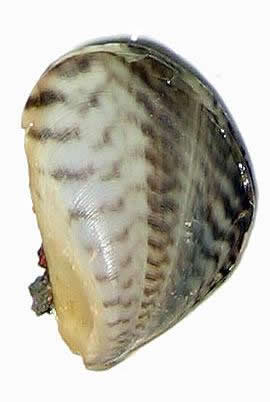 Quagga Mussels: An Invasive Mollusk - September 9, 2009 Jeff Schalau, Associate Agent, Agriculture & Natural Resources University of Arizona Cooperative Extension, Yavapai County The quagga mussel has arrived in Arizona and is a cause for serious concern. The quagga mussel was first identified in Arizona at Lake Mead in January 2007. This was the first record of there presence in the western United States. We should be concerned – especially about the potential for this invader to colonize the Verde River and its tributaries. The quagga mussel (Dreissena bugensis) is indigenous to the Dneiper River drainage of Ukraine. Its spread in that area was noted in the 1890’s where it spread through adjoining canals in Eastern Europe. It now occurs in almost all Dneiper reservoirs in the eastern and southern regions of Ukraine and deltas of the Dnieper River tributaries. In 1989, it was identified in the Great Lakes region. Then, in 1995, it was found in the Mississippi River. How it made it to the Colorado River is uncertain, but it has moved down the Colorado River from Lake Mead and into Central Arizona Project canals and Lake Pleasant. Potential impacts of quagga mussels are numerous. They often form massive colonies that can block water intake affecting municipal water supplies, agricultural irrigation and power plant operation. In the United States, Congressional researchers estimated that zebra mussels, a closely related species established in the Great Lakes region, cost the power industry $3.1 billion in the 1993-1999 period, with their impact on industries, businesses, and communities more than $5 billion. In areas where both species are present, quagga mussels have outcompeted zebra mussels. Quagga mussels are small, freshwater bi-valve mollusks (relatives to clams and oysters) that are triangular in shape with an obvious ridge between the side and bottom. They are filter feeders that consume large portions of the microscopic plants and animals that form the base of the food web and could cause a disruption of the ecological balance in the water body. These invasive mussels can live for three to five years and can release 30,000 to 40,000 fertilized eggs in a breeding cycle and one million fertilized eggs in a year. Quagga mussels do not have many natural predators in North America, but it has been documented that several species of fish and diving ducks have been known to eat them. Natural predators will never eliminate quagga mussels completely, so it is incumbent on us to watch for quagga mussels and take every step possible to prevent their spread. The Arizona Game and Fish Department has developed the “Don’t Move a Mussel” campaign and provides the following guidelines to employ with equipment that has been in contact with known infested waters.
The University of Arizona Cooperative Extension has publications and information on gardening and pest control. If you have other gardening questions, call the Master Gardener line in the Cottonwood office at 646-9113 ext. 14 or E-mail us at cottonwoodmg@yahoo.com and be sure to include your address and phone number. Find past Backyard Gardener columns or submit column ideas at the Backyard Gardener web site: http://cals.arizona.edu/yavapai/anr/hort/byg/. Quagga Mussel Links Arizona Game and Fish Department Information www.azgfd.gov/h_f/zebra_mussels.shtml U.S. Geological Survey Factsheet nas.er.usgs.gov/queries/FactSheet.asp?speciesID=95 U.S. Environmental Protection Agency Publication www.epa.gov/med/grosseile_site/indicators/sos/dreissena.pdf |